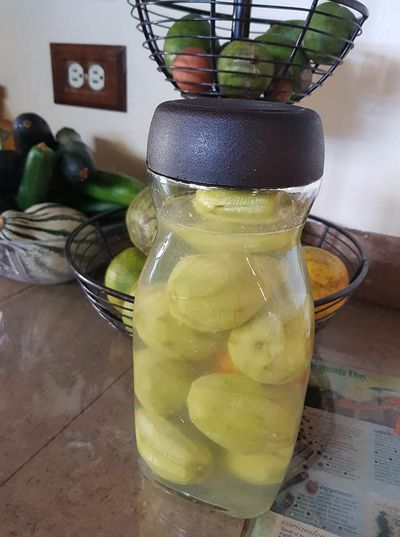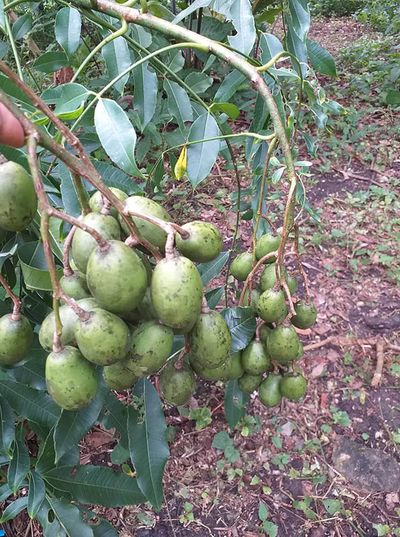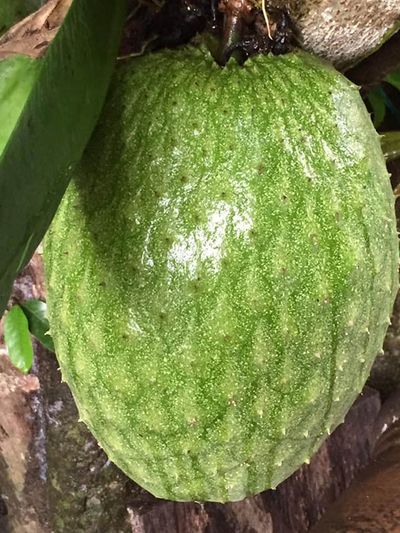Updated • This post may contain affiliate links
10 Exotic Fruits Of Belize You Didn't Know Existed
A few fruits that grow in Belize include breadfruit, craboo, cacao, cashew, golden plum, kenep, mangosteen, noni, starfruit, and soursop.
While Belize doesn't have as many exotic fruits as other countries, it has some bizarre local fruits that are prepared in an equally unusual manner.
Here's the top 10 most popular local fruits: 👇
Breadfruit
Season: July to September
Breadfruit, known as masapan to the local Mayas, is a large and oval green fruit. It can weigh as much as 12 pounds (5.5kg). The seeds inside can be boiled and dried to make alternative flour.


How locals eat it
Breadfruit is commonly eaten fried as a snack. Other ways include:
- Fried in coconut oil
- Boiled or steamed
- Cooked in coconut milk
Quick Facts
- Taste: Potato flavor with taste of fresh bread
- Other Names: masapan, pana, breadnut, mapén, buen pan
- Species Name: Artocarpus altilis
- Nutrition: High in Fiber, Vitamin C, Potassium
Craboo
Season: June to August
Craboo, known as nance in Spanish, is a small round and yellow fruit with a pungent smell. It has a thin shiny skin with white oily flesh and small black pit. The texture is that of an old apple.


How locals eat it
Craboo is commonly eaten fresh and ripe. Other ways include:
- Stewed in a jar with sugar and water
- Fermented in vinegar
- Crushed in evaporated milk
- As craboo wine
- As craboo ice cream.
Quick Facts
- Taste: Combination of pear, lychee, banana
- Other Names: changunga, muruci, murici, nanche, nance, nancite, chacunga, kraabu, savanna serrette
- Species Name: Byrsonima crassifolia
- Nutrition: High in Vitamin C, Fiber, Potassium
Cacao
Season: All Year Round
The cacao tree produces a fruit called a cacao pod which contains seeds called the cacao beans. After the cacao bean is roasted, peeled, and made into a paste, it becomes 100% chocolate.
The cacao bean is precious and is considered the food of the gods by the Mayans. Besides the edible cacao bean, the sweet white flesh that surrounds it can be eaten upon opening the cacao pod.

How locals eat it
Sadly, many locals haven't discovered the magic of cacao. Most of the cacao is only enjoyed by the traditional Maya families and the rest is exported.
Quick Facts
- Taste: Dark, bitter, like unsweetened chocolate
- Other Names: kakaw
- Species Name: Theobroma cacao
- Nutrition: High in Antioxidants, Iron, Magnesium
Cashew Fruit
Season: July to September
The cashew tree bears a cashew seed + cashew fruit which can both be used in various recipes. The cashew nut undergoes a long process before it's considered edible.
Traditionally, the cashew seed is ripped apart from the fruit, sun dried and roasted to remove an external acidic white layer. It's then peeled, roasted once more and then cracked open to reveal the cashew nut.

How locals eat it
Locals eat the cashew nuts after it's been toasted. The cashew fruit is then used to make cashew wine, cashew jam, and cashew stew. Outside Belize, it's normally used as a cheese replacement due to its creamy texture and flavor.
Quick Facts
- Taste: Nutty, cheesy, buttery
- Other Names: caju
- Species Name: Anacardium occidentale
- Nutrition: High in Healthy unsaturated fats, Copper, Antioxidants
Golden Plum
Season: July to September
Golden plum or Amabarella is green fruit with a thick leathery skin and fibrous seeds. It's so fibrous that you might need dental floss after eating this.
When eaten unripe, the flesh is crisp and firm and has a sour taste. After ripening, it becomes yellow, soft and has a sweeter taste.


How locals eat it
This strange little fruit is normally eaten with salt and chili pepper. It can be eaten ripe or unripened. Sometimes, locals put them in a brine of salt water and pepper to preserve for later.
Quick Facts
- Taste: Sour, acidic, mildly sweet
- Other Names: ambarella, june plum, caja manga, casharana, jocote de mico, jobo indio, mangotin
- Species Name: Spondias dulcis
- Nutrition: High in Vitamin C, Phosphorous, Calcium
Kenep
Season: May to June
Kenep or huaya in Belize is a strange fruit. It's a juicy seed with gelatinous orange pulp surrounding it. When ripe, it's bittersweet and juicy in taste.

How locals eat it
Locals love eating kenep just as much as we enjoy eating craboo. It's a pastime for us to grab a bag of these natural treats and eat the entire bag. Finding the ripest and juiciest fruit by observing the quality of the green shell is a fun game to play.
Quick Facts
- Taste: Sweet, acidic
- Other Names: talpa jocote, mamón, limoncillo, skinip, huaya, or mamoncillo
- Species Name: Melicoccus bijugatus
- Nutrition: High in Vitamin C, Vitamin A, Fiber
Mangosteen
Season: July
Mangosteen is a tropical fruit originating from South East Asia. It's the size of a Jamaican lime, has thick skin, normally dark red and purple in color and brown when ripe.
The fruit pulp is white and soft inside with unevenly divided segments. To open the fruit, use a sharp knife to cut around the middle and twist the two halves apart.

How locals eat it
Since it's rare, the common way to eat it is raw after it has ripened. The flavors are exquisite.
Quick Facts
- Taste: Sweet and sour
- Other Names: purple mangosteen
- Species Name: Garcinia mangostana
- Nutrition: High in Antioxidants, Vitamin C, Folate
Noni
Season: All Year Round
Noni is a stinky smelling fruit that claims to have a plethora of health benefits. It's likely called noni because it resembles an anona which is Spanish custard apple.

How locals eat it
Locally, noni is used as plant medicine. It is normally mashed up and taken in spoonfuls as medicine in the morning and evening. Locals combine it with other flavors to make it more pleasant. Alternatively, it is used as wine.
What is it believed to treat?
Noni and its juice is claimed to be used to treat cancer, diabetes, heart disease, cholesterol problems, high blood pressure, HIV, zheumatism, psoriasis, allergies, infection, and inflammation. It's believed that the fruit can relieve sinus infections, menstrual cramps, arthritis, ulcers, sprains, injuries, depression, senility, poor digestion, atherosclerosis, addiction, colds, flu, and headaches. It is further claimed that the juice can heal scratches on the cornea of the eye. This mouthful of information comes from an old local blog post.
Quick Facts
- Taste: Stinky cheese, bitter
- Other Names: morinda, Indian mulberry, beach mulberry, cheese fruit
- Species Name: Morinda citrifolia
- Nutrition: Rich in Antioxidants, Vitamin C, Biotin, Folate
Starfruit
Season: Nov–January & May–August
Starfruit is a unique fruit that resembles a star when cut in cross-section. The entire fruit is edible. The outside has a somewhat waxy skin and the flesh is crunchy, firm, but super juicy.

How locals eat it
When in season, starfruit is normally eaten raw since the whole fruit is edible. We don't do it much, but juicing starfruit would be a good idea along with using it as garnish for drinks and salads.
Quick Facts
- Taste: Combination of apple, pear, grape and citrus
- Other Names: carambolo, balimbing, ma fen, kamaranga
- Species Name: Averrhoa carambola
- Nutrition: High in Vitamin C
Soursop
Season: March to April
Soursop is a fruit that resembles a green egg with spikes from the outside. The inside has a white pulp or flesh that is both sweet and sour with a core of indigestible black seeds.

How locals eat it
Soursop is delicious when eaten raw, but locals prefer preparing it as a juice and even better, as ice cream. It's common to find homemade soursop ice cream at small stores or sometimes sold by vendors on small pickup trucks selling on the streets.
Quick Facts
- Taste: Sweet, sour, like natural ice cream
- Other Names: guyabano, guanábana, anona, graviola, and corossol
- Species Name: Annona muricata
- Nutrition: High in Vitamin C, Antioxidants
More Belize Fruits
- Avocado
- Mango
- Pineapple
- Papaya
- Apple Banana
- Goose Berry
- Pitahaya
- Sea Grapes
- Sac Pah
- Star Apple
- Lychee
- Rambutan
- Guava
- Tamarind
- Passion Fruit
- Coconut
- Orange
- Manderin
- Grapefruit
- Ugli Fruit
- Sweet Lime
- Malay Apple
- Mamey
- Sapodilla
- Custard Apple
Leave A Comment 👇
Need a little more travel advice?
